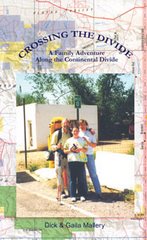
If you become a southbounder you will have to deal with Colorado in the fall. Here is a heads up on when winter can come to Colorado and the San Juan Mountains.
Staff ReportPublished September 22, 2006
The weather on the Continental Divide Trail has taken a turn for the worse in southern Colorado.
Things aren’t looking so good right now for getting through the state without taking a lower route. I am in my tent in the Cochepto Hills watching the snow pile up outside.
It has been snowing for 12 hours straight and there is no sign of it letting up. The forecast for the next two days is for more snow.
I can hear the wind swirling outside, but fortunately I am staying cozy and warm inside my tent, camped in a wooded section of the trail. Coming up a few days from now, however, the trail climbs back above 12,000 feet and is exposed well above timberline as it goes through the San Juan Mountains.
The San Juans are supposed to be one of the highlights of the CDT with magnificent ridge walking, surrounded by 14,000-foot peaks.
Another hiker earlier this year said about the Crede cutoff, "Anyone who skips the San Juans shouldn’t be out here."
But in weather like this, it can be dangerous. In 1848, the John C. Fremont expedition lost a third of its men in a severe blizzard a few days south of where I am now. In 1874, Alfer Packed killed and ate his companions when they were caught in the snowy mountains of the San Juans. I’m out here by myself, so if I get stuck in the snow I don’t even have anyone to eat.
Going over 12,500-foot Hope Pass a few days ago during the last cold front, I experienced a bit of how dangerous it can be above treeline in bad weather.
It was some of the nastiest weather I have ever hiked in–definitely the worst I have been in alone.
I left early because I had heard that snow was forecast for later in the day. It was raining when I got out at the trailhead. I passed a hunter who had a roaring fire going. As I proceeded up the hill the rain turned to snow. It was snowing hard, but I only had three more miles to go to the top of the pass. At first the snow hitting the trail melted, but soon the trail, too, was covered in white. It was still easy to follow though.
The weather wasn’t that bad until I climbed out of the forest about a mile from the pass. The wind whipped the snow in all directions. Each time a cold blast of snow whipped past me I had to stop and bury my head until it passed and I could look up again to see where to go. The wind was coming from all directions.
At one point the wind was blowing a blast of snow down one side of the bowl beneath the pass when another gust came from the opposite direction. The two blasts collided then turned and headed toward me. The force of the wind made me take a couple of steps backward while I braced against it. I was shivering and my hands and face were ice.
At that point I was just below the top of the pass, but I decided to turn around. I had taken a couple of steps downhill before I saw the clouds breaking and the sun trying to shine through.
It was still bitterly cold and the wind was still stirring up whiteout conditions, but the psychological lift of seeing the sun got me to turn around. I got to the top of the pass and the other side was even windier, very little snow was on the slope on that side as the wind had scoured it clean.
I was freezing and hurried down the hill about a mile before getting to some trees that offered me a respite. Out of the wind it wasn’t that bad. I descended into the trees and by the time I got to the road at the bottom of the hill, the sun was shining and I was almost warm.
I am getting a radio station on my MP3 player right now, but it is one of those format stations and I don’t think I will be getting any local weather reports. Right now I am just hoping I will be able to follow the trail in the morning and that at some point in the day I will have a chance to dry out my tent.
The nearest road is 27 miles away. If I make it there tomorrow, I might hitch into a town, provided the road is open and there is any traffic on it.
I left Boulder, Colo., on Sept. 8 and the weather has been mainly cold and snowy since then with a few warm sunny days in-between.
Winter is coming early this year to Colorado. The aspens normally change color at the end of the month and into October. Now they have not only changed color, they are losing their leaves. The usual date for hikers to safely get through the San Juans is Oct. 1, but that isn’t holding true this year.
I hiked out of Boulder with Recess, a friend from the Pacific Crest Trail who came out to hike for a week. It started raining on us quickly after Easy–another PCT friend who lives in Boulder–dropped us off at the trailhead. The rain soon turned to snow.
We hiked up over 12,000 feet to the open divide and into the brunt of the wind. We found a place off the crest and out of the wind to camp. Five inches of snow fell overnight.
The next morning, the weather was just as bad and–with the highest section of the trail coming up with five 13,000-foot peaks–we bailed off the trail at the next pass, hiking a gravel road 14 miles down to Winter Park.
Recess had a rental car and my parents came out the next week with their van. With the help of both of them I managed to bounce around in central Colorado, hiking the lower elevations on colder days and the higher places on warmer days.
Unfortunately the weather caused our southbound group to each do its own thing and we are now a bit more spread out. I am hiking by myself for the first time on the CDT.
There just was a local weather report on the radio–thunderstorms continuing tonight and isolated showers on Thursday and Friday with a chance of snow Friday night. Up here above 10,000 feet that means snow, snow, snow.












No comments:
Post a Comment